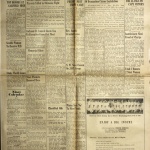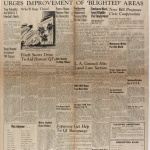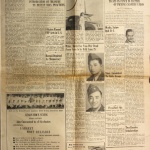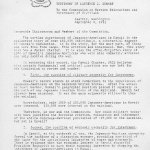Emergency Service Committee
The Emergency Service Committee was an organization comprised primarily of Nisei who sought to prove the loyalty of the Japanese community in Hawai'i during World War II. During the war, the Committee promoted racial unity by spearheading a "Speak-American" campaign, organizing blood drives and the purchase of war bonds, and collecting funds for the Red Cross and the Army and Navy Emergency Relief Societies. The activities of the Emergency Service Committee demonstrated the loyalty of the Japanese community in Hawai'i and the activism of its Nisei members who would rise to prominence in the postwar period. However, it also revealed the extreme insecurity and suspicion in Hawai'i that existed after the Pearl Harbor attack as the Japanese were "definitely on the spot." [1]
Background
Following the Pearl Harbor attack and the institution of martial law , the Japanese in Hawai'i faced legal, social, and economic discrimination by the military and the constant questioning of their loyalty. The Japanese community in Hawai'i responded to the war with extensive efforts to mobilize and to contribute to the overall United States war effort. Prior to the war, some Nisei and non-Japanese had formed the Committee for Interracial Unity in Hawaii, a multiethnic group of civic and military leaders that included Hung Wai Ching , Charles Loomis, and Shigeo Yoshida , who were appointed to the Public Morale Section , first with the Office of Civilian Defense and a month later under the Office of the Military Governor. Under the Morale Section, various organizations were formed within different ethnic communities, such as the Emergency Service Committee, that was organized to work with the Japanese community. The purpose of this organization was to "channel the inherent loyalty of the people of Japanese ancestry into a program of active participation in the war effort" and to counter the "insecurity and fear" they felt after the Pearl Harbor attack. [2]
Actions of the Emergency Service Committee
Members of this group worked as liaisons with the military on matters affecting the Japanese community and assured the military of the complete loyalty of the Japanese population. They disseminated information at 209 meetings, contacting approximately 10,000 individuals from February through December 1942, relieving community anxieties during a period when authorities had suspended Japanese radio broadcasts and newspapers.
The Emergency Service Committee also spearheaded various efforts in the Japanese community to prove the loyalty of its members. They secured their leadership role within the Japanese community by dissolving Japanese societies and institutions, such as language schools and Shinto shrines that were traditionally considered sources of nationalistic sentiment. [3] Authorities had interned many of the priests and language teachers immediately following the attack, and they were thus helpless to prevent the dissolution of their organizations. Members also confiscated $2.4 million dollars in frozen bank assets from three leading Japanese banks in the territory, and the money was converted into war bond purchases. [4] Through letters and personal phone calls, they collected $147,408.75 that was invested in war bonds. In June 1943, members raised over $10,000 for the "Bombs on Tokyo Campaign." [5] This concerted effort to control the finances of the Japanese community was designed to eliminate sources of funding and impoverish traditional leaders. While the Office of the Military Governor supported these actions, it was the Nisei who implemented these policies and challenged any sort of alternative discourse on the war through self-censorship of the community.
Self-Censorship of the Japanese Community
Under martial law, Japanese newspapers in Hawai'i were ordered to stop their presses and, although no similar orders were issued to other Japanese businesses and institutions, the doors to Japanese schools, Buddhist temples, and Shinto shrines closed as most of the teachers and priests had been interned. Almost overnight the Japanese community was deprived of its social, educational, and religious leaders, which created a void in leadership and aroused anxiety among the Japanese about their future in Hawai'i. This tactic so successfully suppressed leadership in the Japanese community that in 1943 and 1945, with only one exception, there were no individuals of Japanese ancestry in elected office in the territory despite Japanese constituting nearly twenty-nine percent of the total voter pool. [6] Only a few years earlier in 1941, there were six representatives and one senator of Japanese ancestry in the territorial legislature, along with six Japanese on the county boards of supervisors. Many Japanese candidates who had previously been politically active elected not to run for public office during the war due to the politically volatile situation. In addition, Japanese voters hesitated to support Japanese candidates for fear that the Japanese community would be seen as trying to take over the government.
In order to prove their loyalty and appear as "American" as possible, the Japanese replaced Japanese radio programs and films with English programs and American films, and a "Speak-American" campaign was launched in the Japanese community by the Emergency Service Committee. [7] These drastic actions reflected an underlying fear in the Japanese community about the tenuous position they occupied during a war with the nation of their origin. The reaction of the Japanese community to the outbreak of war not only reflected the general mobilization of Hawai'i as an important military station but also the anti-Japanese sentiment expressed by other ethnic groups, particularly by the Koreans and the Filipinos. This racial hostility had its origins in the plantation system that exploited ethnic differences between migrant groups to weaken interethnic bonds and strengthen the position of the white management in a strategy known as "divide and rule." [8] Despite the best attempts of Japanese to be "patriotic" and "American," the war gave new vitality to a long-standing animosity toward Japanese.
According to historian Gary Okihiro, the Emergency Service Committee constituted a " nisei counter propaganda system directed against ethnic identity and culture" as the second generation led the way in the self-censorship of the Japanese community. [9] Many Issei feared venturing beyond their homes because their presence constituted an embarrassment and sometimes danger to the community. "We are afraid. We don't know what to do," testified one Issei. "Even our own children don't let us go out. If we go out, we will be the focus of hate and revenge. So we stay in the house." [10] The Nisei, too, were held hostage because of race. They were frequently reminded they were "on the spot" and had to act in ways that would not irritate others or offend whites.
Although persons of varying ethnic backgrounds had lived and worked side-by-side for many years, there was an undercurrent of anti-Japanese feeling even before December 7th. The Japanese attack and the Pacific War caused these latent feelings to surface. Others had doubts about the loyalty of Japanese-Americans because they followed Japanese customs, went to language schools, and were thought to be generally clannish. "Once a Jap, always a Jap" was a phrase often heard in wartime Hawai'i. [11] Many Japanese understood the hostility and suspicion directed at them as this tension-filled situation ignited racial fears and hostilities, culminating in the internment of nearly 1,500 Japanese in the Islands. Thus the Emergency Service Committee served an important purpose in deflecting anti-Japanese sentiment during the war.
For More Information
Allen, Gwenfread. Hawaii's War Years: 1941-1945 . Honolulu: The Advertiser Publishing Co., Ltd, 1950.
Anthony, J. Garner. Hawaii Under Army Rule . Honolulu: The University Press of Hawaii, 1955.
Emergency Service Committee. The AJA—Their Present and Future . Honolulu: n.p., [1940?].
Hatanaka, Yuriko and Kimie Kawahara. "The Impact of War on an Immigrant Culture." Social Processes in Hawaii vol. VIII (Nov. 1943): 36-44.
Hawaii, Office of the Military Governor, Morale Section, Emergency Service Committee. Report of the Emergency Service Committee . Honolulu: n.p., 1944.
Hawaii, Office of the Military Governor, Morale Section, Emergency Service Committee. Final Report of the Emergency Service Committee . Honolulu: n.p., 1946.
Hawaii, Office of the Military Governor, Morale Section, Emergency Service Committee. Report of the Emergency Service Committee . Honolulu: n.p., 1945.
Hazama, Dorothy Ochiai and Jane Okamoto Komeiji. Okage Same De: The Japanese in Hawai'i 1885-1985 . Honolulu: Bess Press, 1986.
Kimura, Yukiko. "Some Effects of the War Situation Upon the Alien Japanese in Hawaii." Social Process in Hawaii vol. VIII (Nov. 1943): 18-28.
Ogawa, Dennis. Kodomo No Tame Ni: For the Sake of the Children . Honolulu: University of Hawaii Press, 1978.
Okihiro, Gary Y. Cane Fires: The Anti-Japanese Sentiment in Hawaii, 1865-1945 . Philadelphia: Temple University Press, 1991.
Scheiber, Harry N. and Jane L. Scheiber. "Constitutional Liberty in World War II: Army Rule and Martial Law in Hawaii: 1941-1946." Western Legal History 3L 2 (1990): 341-378.
Souza, Blaise Camacho. "Boosting Morale is a Cheerful Task on Home Front." Honolulu Star Bulletin , Sept. 13, 1999, Fifth Part.
Tsukiyama, Ted. "Hung Wai Ching." http://www.javadc.org/hung_wai_ching.htm .
Yoshida, Shigeo. "Emergency Service Committee." Jun. 1972. http://www.100thbattalion.org/archives/puka-puka-parades/wartime-hawaii/emergency-service-committee/ .
Footnotes
- ↑ Hawaii, Office of the Military Governor, Morale Section, Emergency Service Committee. Research for this article was supported by a grant from the Hawai‘i Council for the Humanities .
- ↑ Hawaii, Office of the Military Governor, Morale Section, Emergency Service Committee, Final Report of the Emergency Service Committee (Honolulu: n.p., 1946), 1; Hawaii, Office of the Military Governor, Morale Section, Emergency Service Committee, Report of the Emergency Service Committee (Honolulu: n.p., 1945), 1.
- ↑ Hawaii, Office of the Military Governor, Morale Section, Emergency Service Committee, Final Report of the Emergency Service Committee (Honolulu: n.p., 1946), 17.
- ↑ Ibid., 19.
- ↑ Ibid., 22.
- ↑ Emergency Service Committee, The AJA—Their Present and Future (Honolulu: n.p., [1940?]), 9.
- ↑ Gwenfread Allen, Hawaii's War Years: 1941-1945 (Honolulu: The Advertiser Publishing Co., Ltd, 1950), 351.
- ↑ Dennis Ogawa, Kodomo No Tame Ni: For the Sake of the Children (Honolulu: University of Hawaii Press, 1978), 7.
- ↑ Gary Y. Okihiro, Cane Fires: The Anti-Japanese Sentiment in Hawaii, 1865-1945 (Philadelphia: Temple University Press, 1991), 274.
- ↑ Yukiko Kimura, "Some Effects of the War Situation Upon the Alien Japanese in Hawaii," Social Process in Hawaii vol. VIII (Nov. 1943): 18.
- ↑ Dorothy Ochiai Hazama and Jane Okamoto Komeiji, Okage Same De: The Japanese in Hawai'i 1885-1985 (Honolulu: Bess Press, 1986), 130.
Last updated Jan. 4, 2024, 1:17 a.m..







